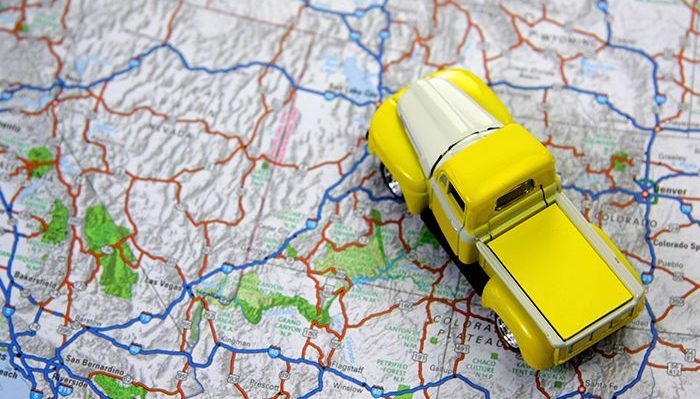Using geofencing to reduce traffic location fines
Feb 28, 2019 • Features • Verizon • fleet management • Geofencing
Derek Bryan, VP EMEA at Verizon Connect suggests geofencing could prevent fleet drivers being in the wrong place at the wrong time, avoiding costly penalties.
In April 2019, London’s congestion charge will evolve, bringing in new, tighter regulations on exhaust emission standards and a revised fee for vehicle registration as part of the new Ultra Low Emission Zone (ULEZ). While the ULEZ represents an important step forward in the UK’s efforts to limit pollution, fleet managers and operations teams will need to factor the revised regulations into route planning and operations for commercial vehicles travelling into London.
In an industry driven by operational efficiency and narrow margins, the planning for ULEZ (and its potential expansion) will become an additional item on a manager’s to-do list. Geofences are one tool fleet managers can use to help reduce penalties incurred by drivers inadvertently entering the ULEZ with a non-compliant vehicle by providing near-real-time alerts when a driver approaches a geofenced zone. It can also help reduce the extra time spent factoring the ULEZ into route planning by clearly marking the area in navigation systems.
What is Geofencing?
Geofences are virtual perimeters set up around physical locations that can be categorised and clearly labelled on in-cab navigation systems to inform drivers of any areas which they should avoid entering. Geofences are created using mapping software, which allows the user to draw the geofence over the desired area. It is made up of a collection of coordinates (latitude and longitude), or in the case of a circular geofence, one point that forms the centre. They can also be applied to areas of a range of different sizes, from the size of a warehouse yard to city areas and individual routes.
Geofences are an indispensable tool for fleet managers in need of greater control and visibility over the location of vehicles. A geofence violation report tells you which vehicles have entered or exited a geofence, allowing you to see which drivers are making unauthorized trips. This information can then be used to create new policies regarding the use of company vehicles and enforce existing policies on a regular basis. Geofences can also help fleet managers to proactively resolve geofence violations with great speed and efficiency using alerts sent in near-real time via email or text message when a vehicle exits or enters a geofence.
More intelligent and more efficient operations
Setting virtual boundaries via geofencing is specifically helpful for businesses with on-demand business structures managing fleets of vehicles within a specified area. To keep time traveling between jobs to a minimum, drivers can be easily assigned to specific zones based on area demand, traffic density, vehicle capacity and in this instance, if it is within ULEZ conditions. As a result, fleets can be compartmentalised into sub-groups of drivers or vehicles suited to a specific area.
"Geofences are an indispensable tool for managers in need of greater control over the location of vehicles..."
Geofencing is used to curate and categorise job sites by location, reducing the need to sift through thousands of points of interest by hand. However, geofencing jobs can not only cut down on manual categorisation. A business can potential unlock real ROI when the software automatically provides rankings, vital statistics and stop-by-stop details for fleet managers. Using this key data, business leaders can optimise routes and glean insight to apply to the organization, ultimately saving money.
A smarter and more holistic fleet management system
A number of recent technological advancements are helping to enable a wide range of new business use cases in the fleet management space. In-vehicle sensor technology, greater data analytics capabilities and enhanced mobile communications enable businesses to expand fleet management beyond just vehicles and have greater visibility on drivers themselves and the assets they carry.When used in combination with a holistic solution such as Mobile Resource Management (MRM), geofences can help verify that drivers aren’t taking on trips that would require more time than they are contracted, or trips that would prevent drivers from taking important rest breaks. Reports clearly show how many hours a driver has worked during a given time period, confirm any overtime costs and improve productivity overall.
A digital solution for a modern business
A lot of managers are unaware of what’s really happening out in the field. That can mean missed opportunities, poor productivity or unnecessary costs. Geofences can help change that, with a full 360-degree view of a fleet’s daily operations. With the right technology, fleet managers can have the visibility necessary to know what’s going on in the field so you can build efficiencies and reduce costs, an imperative for fleets both large and small.
Derek Bryan is VP EMEA at Verizon Connect.





















 Field Service News is published by 1927 Media Ltd, an independent publisher whose sole focus is on the field service sector. As such our entire resources are focused on helping drive the field service sector forwards and aiming to best serve our industry through honest, incisive and innovative media coverage of the global field service sector.
Field Service News is published by 1927 Media Ltd, an independent publisher whose sole focus is on the field service sector. As such our entire resources are focused on helping drive the field service sector forwards and aiming to best serve our industry through honest, incisive and innovative media coverage of the global field service sector.
Leave a Reply